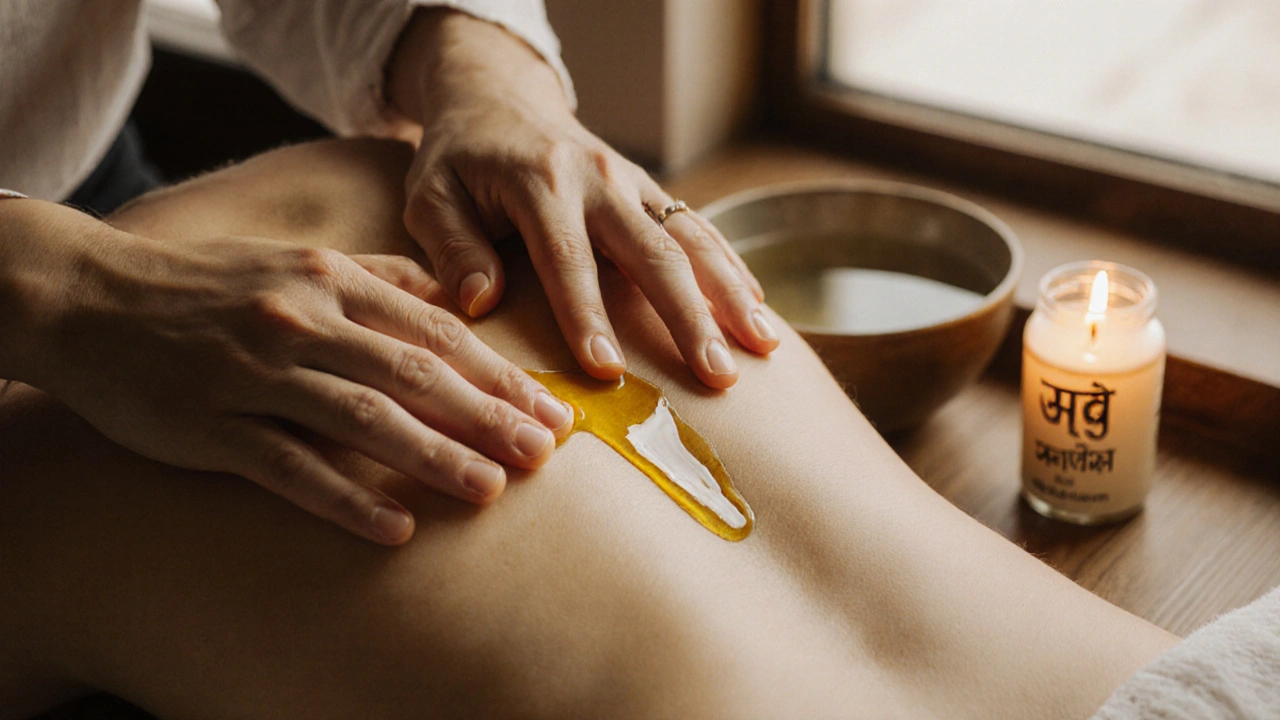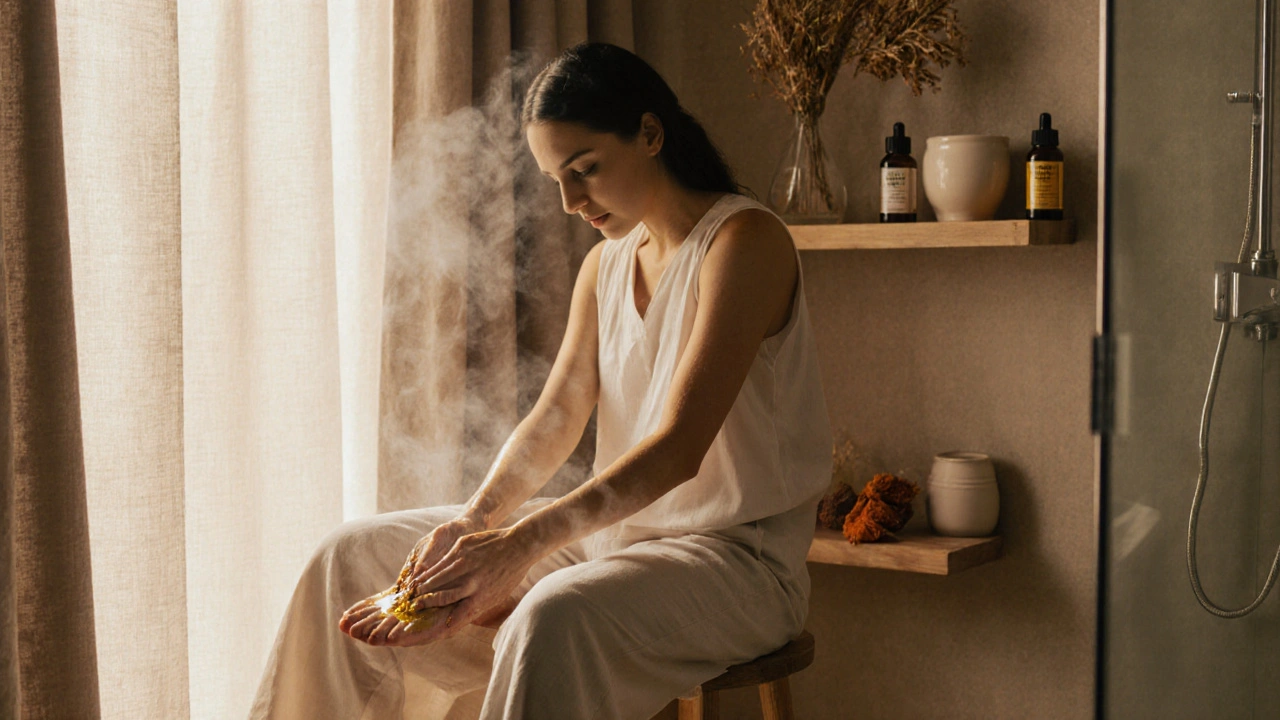Abhyanga Oil Selection Tool
Choose Your Dosha
Your Specific Needs
Imagine starting your day not with caffeine or scrolling through your phone, but with warm oil gliding over your skin, your muscles relaxing, your mind quieting. This isn’t luxury-it’s ancient medicine. Abhyanga oil massage, practiced for over 5,000 years in Ayurveda, isn’t just about feeling good. It’s a daily ritual that rewires your nervous system, boosts circulation, and helps your body reset. And you don’t need a spa or a therapist to do it. All you need is 15 minutes, some warm oil, and the willingness to slow down.
What Exactly Is Abhyanga Oil Massage?
Abhyanga is a Sanskrit word that means "to rub in"-specifically, the full-body massage with warm herbal oils. In Ayurveda, the traditional healing system from India, this isn’t optional. It’s as essential as brushing your teeth. The oil isn’t just for your skin. It’s medicine. It penetrates deep, nourishes your tissues, and helps flush out toxins your body can’t clear on its own.
Unlike Western massage that targets knots or sore muscles, abhyanga works on the deeper level-the doshas. These are your body’s three energies: Vata (air and space), Pitta (fire and water), and Kapha (earth and water). Most people in modern life are stuck in Vata imbalance-scattered, anxious, dry, and overstimulated. Abhyanga calms Vata. It grounds you.
The oils used aren’t random. Sesame oil is the most common-it’s warming, rich in antioxidants, and penetrates deeply. Coconut oil is cooling, great for Pitta types. Almond oil is gentle and nourishing. Some blends include herbs like ashwagandha, turmeric, or calamus, steeped into the oil for extra healing power.
Why It Works: Science Meets Tradition
You might think this is just an old wives’ tale. But modern science backs it up.
A 2020 study in the Journal of Ayurveda and Integrative Medicine found that daily abhyanga reduced cortisol levels by 28% in participants over four weeks. Cortisol is your stress hormone-the one that keeps you wired, breaks down muscle, and messes with sleep. Lower cortisol means better sleep, less belly fat, and fewer mood swings.
Another study showed that regular oil massage improves lymphatic drainage. That’s your body’s waste removal system. When it’s sluggish, you feel puffy, tired, and prone to illness. Abhyanga wakes it up. The rhythmic strokes stimulate lymph nodes, helping your body clear out metabolic waste and inflammation.
And then there’s the skin. Your largest organ. Most people use lotions that sit on top. Abhyanga oils penetrate. They rebuild the lipid barrier, lock in moisture, and reduce fine lines. People with eczema, psoriasis, or dry skin often report dramatic improvement after just a few weeks.
How to Do It Right: A Simple Step-by-Step Guide
You don’t need to be an expert. Here’s how to do abhyanga at home, in under 20 minutes:
- Choose your oil. For Vata (anxious, cold, dry): warm sesame oil. For Pitta (hot-tempered, oily skin): coconut or sunflower oil. For Kapha (heavy, sluggish): almond or mustard oil. Start with 1/4 to 1/2 cup.
- Warm the oil. Place the bottle in a bowl of warm water for 5 minutes. It should feel like a warm bath-not hot, not cold.
- Start with your scalp. Use your fingertips to massage in circular motions. This boosts circulation to your brain and helps with headaches and insomnia.
- Move to your face. Gently stroke outward from your nose to your ears. Avoid pulling on delicate skin.
- Arms and legs. Use long strokes toward your heart. This helps blood and lymph flow back. Don’t rush-spend at least 2 minutes on each limb.
- Abdomen and chest. Use clockwise circles for digestion. Gentle strokes across your chest for calm.
- Back and feet. If you can’t reach your back, use a long-handled brush or ask someone to help. Feet are especially important-massage the soles with firm pressure. It’s said to calm the nervous system.
- Wait 10-15 minutes. Let the oil soak in. Don’t rush to shower. This is when absorption happens.
- Shower with warm water. Use a gentle soap if needed. Don’t scrub. Let the oil rinse off naturally.
Do this in the morning before your shower. It’s a ritual-not a chore. Light a candle. Play soft music. Breathe. This is your time.

Who Should Try It-and Who Should Skip It
Abhyanga is safe for almost everyone. But there are exceptions.
Great for:
- People with chronic stress or anxiety
- Those with dry skin, eczema, or psoriasis
- Insomniacs or people who wake up tired
- Anyone feeling mentally scattered or overwhelmed
- Menopausal women (reduces hot flashes and night sweats)
Hold off if you have:
- An active fever or infection
- Open wounds, burns, or severe skin rashes
- Acute inflammation (like a swollen joint from gout or arthritis flare-up)
- Pregnancy-unless guided by a qualified Ayurvedic practitioner
If you’re on blood thinners or have a bleeding disorder, talk to your doctor first. The massage isn’t aggressive, but increased circulation can affect medication.
Real Results: What People Actually Experience
One woman in Perth, 52, started abhyanga after years of insomnia and joint pain. She used warm sesame oil with a drop of lavender. Within two weeks, she fell asleep faster. After a month, her knee stiffness dropped by 60%. She didn’t stop her physiotherapy-but she stopped needing painkillers.
A 34-year-old teacher in Fremantle did it every morning before school. She said her anxiety attacks stopped. "I used to feel like my thoughts were racing on a treadmill," she told me. "Now I feel like I’m standing still. Calm. Present."
It’s not magic. It’s consistency. You don’t need to do it perfectly. Miss a day? No guilt. Just start again tomorrow.

How to Choose the Right Oil
Not all oils are created equal. Here’s what to look for:
- Organic, cold-pressed: Avoid refined or chemical-extracted oils. They’re stripped of nutrients.
- Unfragranced: If it smells strongly of perfume, skip it. Natural oils have a mild, earthy scent.
- Herbal-infused: Some brands add ashwagandha, brahmi, or neem. These are powerful for stress and skin. Look for brands that list the herbs on the label.
- Storage: Keep oil in a dark glass bottle, away from sunlight. Use within 6 months.
Popular brands in Australia include Charaka, Banyan Botanicals, and Kerala Ayurveda. You can also make your own: steep dried herbs in sesame oil for 2-4 weeks in a sunny window, then strain.
Make It a Habit
The biggest mistake? Treating abhyanga like a weekend treat. It works because it’s daily. Like brushing your teeth, it’s preventive, not reactive.
Set a reminder. Do it before your morning coffee. After your shower, if you’re more of a night person. Even 10 minutes counts.
Keep the oil next to your shower. Put a small bottle in your gym bag. If you’re traveling, bring a travel-sized container. Consistency is the secret ingredient.
This isn’t about perfection. It’s about presence. When your hands are on your skin, your mind can’t be scrolling, worrying, or planning. You’re here. You’re alive. You’re caring for yourself-and that’s the most radical act of self-love there is.
Can I use regular coconut oil for abhyanga?
Yes, but make sure it’s cold-pressed and unrefined. Refined coconut oil has been chemically processed and loses its healing properties. Cold-pressed coconut oil is mild, cooling, and great for Pitta types or hot climates. Just warm it slightly before use-it solidifies at room temperature.
How often should I do abhyanga?
Daily is ideal, especially if you’re stressed, tired, or have dry skin. If that feels overwhelming, aim for 3-4 times a week. Even once a week still helps. The key is regularity, not intensity.
Will abhyanga clog my pores?
No. Unlike heavy creams, Ayurvedic oils are designed to penetrate deeply and then be rinsed off. They don’t sit on the skin. In fact, they help unclog pores by dissolving trapped sebum and toxins. People with acne-prone skin often see improvement after switching to abhyanga.
Can I do abhyanga if I’m not Indian or don’t follow Ayurveda?
Absolutely. Abhyanga isn’t tied to religion or culture. It’s a physical therapy rooted in physiology. People from all backgrounds use it-from busy parents in Toronto to firefighters in Sydney. You don’t need to believe in doshas to feel the benefits of warm oil, slow touch, and quiet time.
What if I don’t have time for a full-body massage?
Start small. Massage just your feet for 5 minutes before bed. Or rub oil into your scalp and neck while you’re waiting for your coffee to brew. Even 3 minutes of focused touch lowers stress hormones. Progress, not perfection, is the goal.
Next Steps: Try It This Week
Buy a bottle of organic sesame oil. Warm it up. Spend 10 minutes tomorrow morning massaging your arms, legs, and feet. Don’t think about it. Just do it. Then notice how you feel after your shower. Calmer? Lighter? More present?
If you do, you’ll understand why this 5,000-year-old practice still works today. It’s not about the oil. It’s about the pause. The touch. The quiet. That’s what we all need-more of it.


 Health and Wellness
Health and Wellness